


This beginner’s guide will explain exactly what email marketing is and how it works. By the end, you’ll have a solid grasp of the basics along with the know-how to launch an effective email marketing strategy for your business. 🚀
Email marketing is the most profitable and cost-effective direct marketing channel, generating an average return on investment of $42 for every $1 spent (DMA, 2019).
For this reason alone, email should be a key pillar of your digital marketing strategy. Not doing any email marketing is like leaving money laying out on the table. 💸
But if you’re a bit confused about where to start, that’s totally normal. Email is a vast discipline. It’s easy for beginners to get lost in a sea of tools, techniques, and terminology.
To learn more, stick around for everything you need to know about email marketing:
- What is email marketing
- Why your business needs email marketing in 2022
- How does email marketing work
- How to start email marketing: tools and tips
- How to launch your first email marketing strategy in 8 steps
- 10 strategies for successful email marketing
What Is Email Marketing?
Email marketing is sending commercial emails to a list of contacts who have given their express permission to receive email communications from you.
You can use email marketing to inform your contacts, drive sales, and build a community around your brand, like with a newsletter.
Modern email marketing has moved away from one-size-fits-all mass mailings and instead focuses on consent, segmentation, and personalization. 🆕 This may sound time-consuming, but marketing automation does the heavy lifting for you.
Examples of different types of emails in marketing
Emails can be promotional, informational, or serve a specific purpose in the buyer journey.
Promotional emails
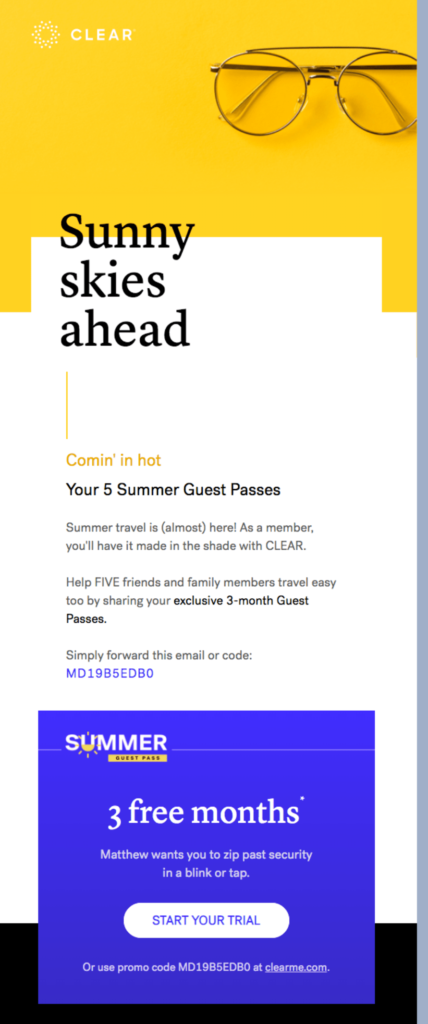
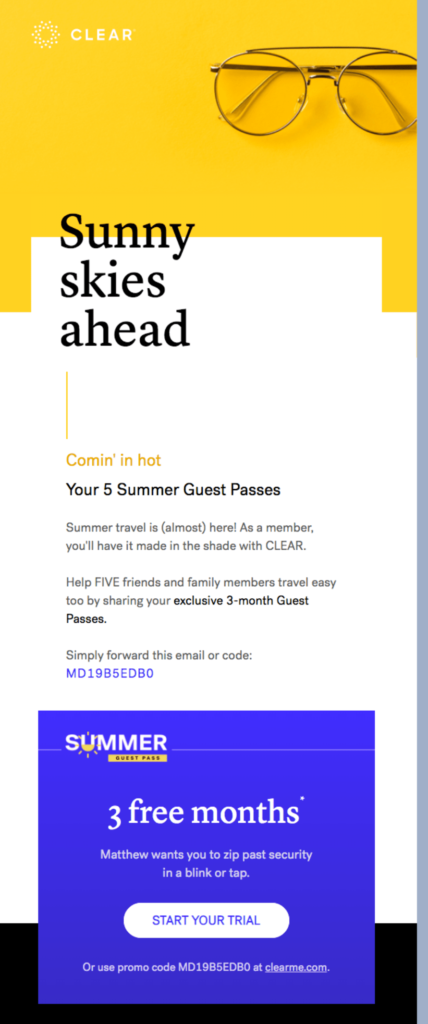
Email marketing campaigns are used to promote special offers, new product releases, gated content like ebooks and webinars, and your brand at large. A campaign could consist of 3 – 10 emails sent over several days or weeks.
Promotional emails have a clear call-to-action — or CTA, for short. The CTA represents the specific action you want the reader to take, whether it’s visiting a page on your website or using a coupon to make a purchase.
Your business’s sales and marketing rhythm should determine the frequency of this type of marketing email. ⏱️ During crucial periods like Black Friday, you may be sending multiple promotional emails in the same 24-hour period. During slower periods in the marketing calendar, there may be a few weeks between your promotional campaigns.
See also: The Best Summer Email Campaign Ideas to Engage Your Readers
Informational emails
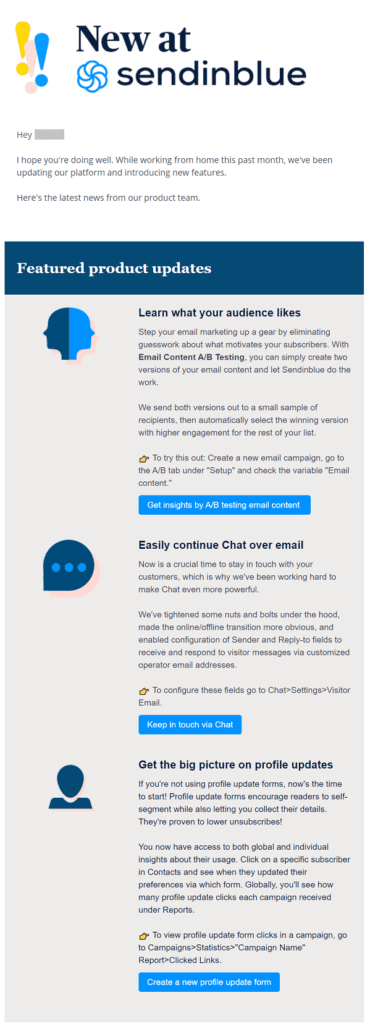

Newsletters: A newsletter, as the name suggests, shares news related to your business. 📰 Think: new milestones reached, new product capabilities, or to feature valuable content like case studies about your product. Sent at regular intervals — weekly, bi-weekly, monthly — newsletters help maintain consistent touch points with your email subscribers.
But did you know newsletters don’t just have to be about ‘news’? As email expert Ann Handley says, focus on the letter aspect. Imagine you’re writing a one-on-one letter to your subscribers about something that interests them.
Simply put, a newsletter is an opportunity to share insights, thoughts, tips – whatever brings the most value to your audience.
Announcements: Email is the perfect way to inform customers of company announcements, new releases of a product, changes to the service, etc. 📢
More often than not, email is the go-to channel for important messages. If there’s a glitch on your website, shipping delays, or an outage in your system/software, updating your contacts via email is the best way to maintain communication. It’s secure, instant, and can match the formal tone of even the most important announcements.
Further reading: What Is A Newsletter? Definition, Purpose & Benefits
Re-engagement emails
Another important type of marketing email is the re-engagement email. As the name suggests, re-engagement emails work to reconnect with customers or subscribers who haven’t been active lately.
Take a look at this example from Shopify:
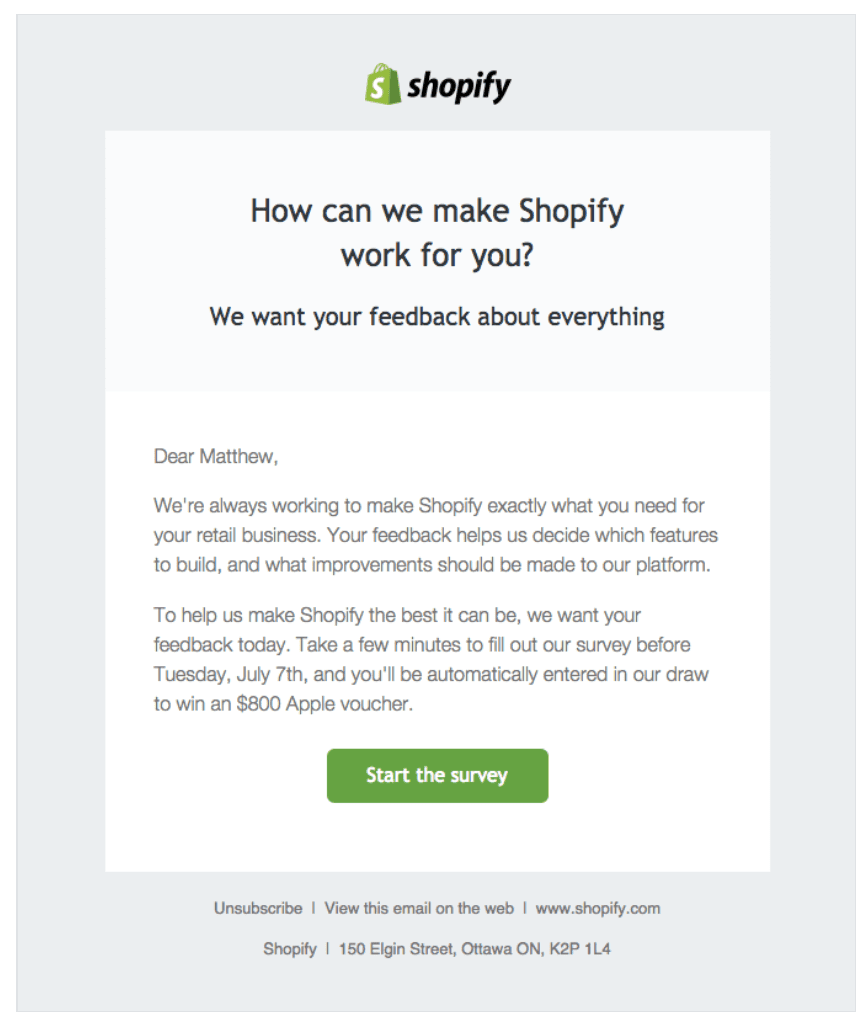

In this example, the re-engagement offer gives the customer the chance to provide feedback on Shopify’s platform.
Other options for re-engaging contacts include offering them a unique discount, sending them a birthday message and coupon, updating them on news about your product/service, and doubling checking their contact preferences.
Is email marketing still important in 2022?
Email isn’t a new technology. In fact, it was one of the very first means of digital communication to arrive back in 1971. But get this: Email marketing — at 50 years old — is used today more than ever before. 🤩
You may be thinking, “Do people really still use email? Isn’t social media where it’s at for marketing today?” While it’s true that social media is an important channel for any digital marketing strategy, email has several advantages.
First, email marketing campaigns can be personalized to a greater extent than those on social media. Next, costs are considerably lower than for other channels, especially considering the reach and conversion rate associated with email marketing. This is part of what makes email marketing so ideal for small businesses.
Finally, what makes email marketing so powerful and lucrative is that it gives you direct, individual access to your audience’s inboxes.
Still don’t believe us? Let’s take a look at the numbers:
- In 2020, there were over 4 billion global email users.
- 80% of Americans check their email at least once per day, with nearly a quarter of them checking their personal email several times a day.
- 62% of consumers ranked email in their top preferred communication channels with small businesses.
Given the figures, not having an email marketing strategy means missing out on sales opportunities and the chance to build lasting customer relationships. 🔗
The Benefits of Email Marketing
From order confirmations to newsletters, emails are an essential part of the growth and management of your business.
Email marketing helps you achieve 3 key objectives:
1. Conversions (selling your products and services)
Launching a sale or promotion? You can send your subscribers an email marketing campaign to drive sales. 🤑 In addition, try using these email marketing techniques to further boost conversions:
- Personalized coupons or special offers for subscribers’ birthdays/anniversaries, in welcome emails, and as a way to re-engage your audience.
- Abandoned cart emails triggered whenever a visitor adds an item in their cart but doesn’t check out.
2. Brand awareness
What’s great about email is that it lets you reach someone directly. It’s one-to-one communication at its best. And people don’t just let anyone into their inbox these days. It’s a curated space reserved for favorite brands and publications.
Showing up in someone’s email inbox will help your brand stay current in the minds of subscribers. A personalized marketing email is more impactful than a social media post where you can’t be sure if someone has actually seen your message. 🤷♂️
One of the major benefits of email marketing is its scalability. This means that emails can be sent to a large number of recipients while remaining cost-effective (compared to other marketing channels).
3. Customer loyalty
Email drives customer loyalty at every stage of the buyer journey: lead-nurturing, conversion, onboarding, retention. As well, email marketing is a necessary tool to use alongside sales CRM systems to streamline communication.
It’s truly a powerful way to build a community, as discussed in our guide to building relationships with email. 🧑🤝🧑
To learn more about the benefits of email marketing, watch this video from the Sendinblue Academy:
Why email marketing is important
Accessibility
Email is accessible to all age groups. It opens the door to a wide range of audiences — even the least digitally-savvy among us.
We might live in the digital age but not everyone is super comfortable using the internet. However, most people do know how to check their email. This makes it the most mainstream form of digital marketing.
Affordability
Email marketing is extremely cost-effective. Most email marketing tools offer pricing packages to suit all budgets. To make the most of your marketing efforts, you really need an email marketing service.
Many email tools — Sendinblue included — offer free plans. These are ideal for first time email marketers who want to get a hang of the software before purchasing. With nothing to lose, there’s no excuse not to give it a go.
Want to know the cheapest email marketing tools? Check out: 12 Mailchimp Alternatives Compared by Price
You own your email list
Think about it: If your social media disappeared, you’d lose all your followers with it. You’d be left with nothing. But this is also what makes an email list special— it’s yours. 🤗
So if all else goes belly up, you’ll still have a direct line of contact with the people who are most interested in your brand. This is why having your own email list is so beneficial. And the intimacy of email as a one-to-one channel will bring you even closer to that audience.
How Does Email Marketing Work? Introducing ESPs
Businesses use what’s known as email service providers (ESP) to send marketing emails.
An email service provider is software that sends and manages email marketing campaigns.
It’s also referred to as an email marketing platform, email marketing tool, email marketing service, or email marketing software.
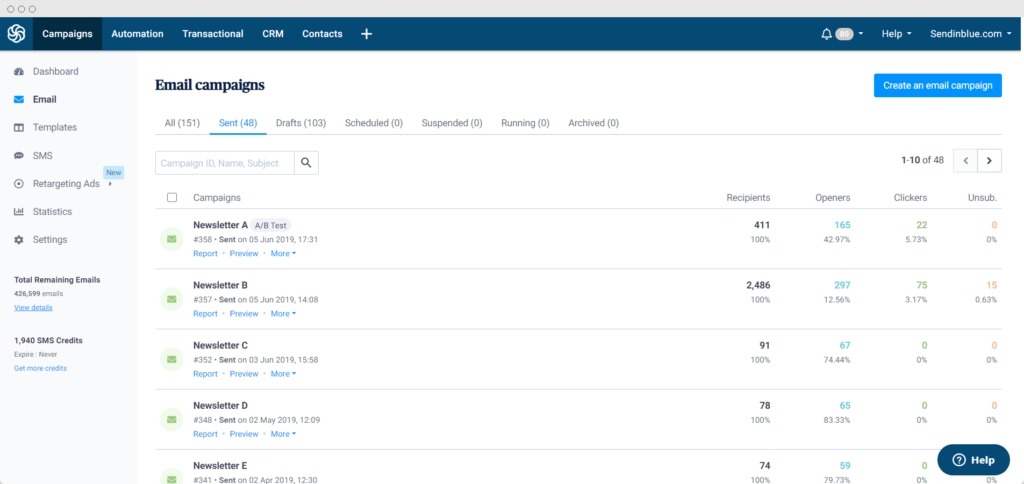

Now you might be wondering, can’t I just send marketing emails with my regular inbox provider? Do I really need to pay for a product on top of that?
Technically, it’s possible. (We even explain how in our guide to sending mass email with Gmail). Beware, though. You’re likely to run into problems with limited email bandwidth, design, and more importantly, email deliverability. Here’s why:
Internet Service Providers (ISPs) like Gmail, Outlook, Yahoo, etc. are designed for personal use — not for email blasts. So when a mass email is sent from an ISP, it’s easily flagged by spam filters and your account can be disabled for suspicious activity. 😔
ESPs, on the other hand, have the necessary infrastructure in place to ensure good email deliverability rates — i.e., the ability to land emails in your subscribers’ inboxes. If you want to set yourself up for email marketing success from day one, get yourself a dedicated email marketing service.
How to Start Email Marketing: What Do I Need?
Keeping it simple, there’s two main things you need to run email marketing campaigns.
1. Email marketing software
As we’ve just explained, a dedicated email marketing provider is the way to go. Sending marketing emails through an ISP will only put your brand and email sender reputation at risk.
2. An email list
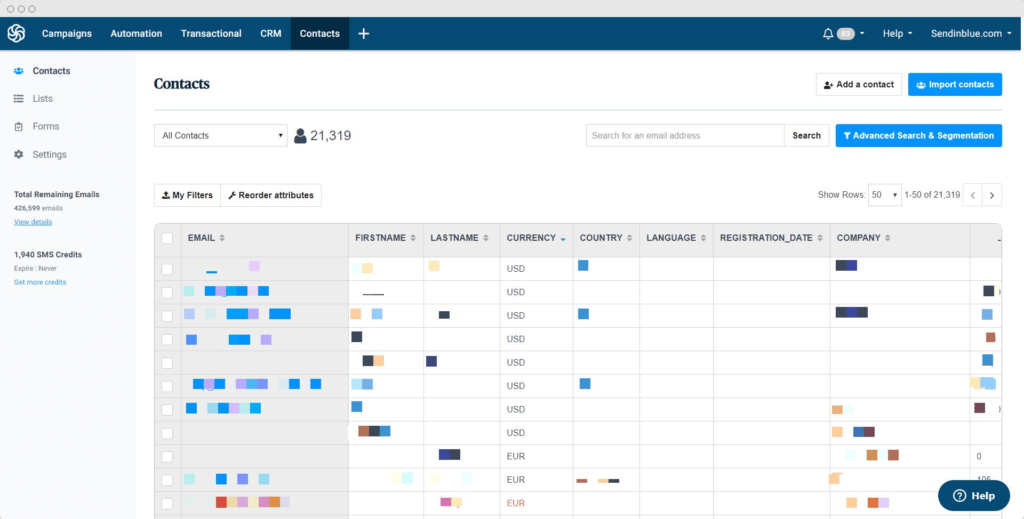

This list should contain the email addresses of interested subscribers who have opted-in to receive email communications from you.
Yes, that’s right — opt-in. Because here’s the thing about email contacts:
Everyone on your email list needs to have given their express permission to be there.
What does that mean?
It means they agreed to receive emails from you when they entered their email address into an email signup form on your blog, website, landing pages, social media, or anywhere else. In email terms, this consent is referred to as an ‘opt-in.’ (‘Opting out’ would be an unsubscribe).
Permission-based marketing is essential to conform with data protection laws and safeguard the integrity of your brand. After all, nobody likes a spammer. 🙅♀️
Still with us? Great, because here’s where it gets exciting — learning how to launch an email marketing strategy, starting with your first email campaign.
How to Launch Your First Email Marketing Campaign in 8 steps
1. Choose the right email marketing software
The first step is finding an ESP to send and manage your email campaigns and email subscribers.
Popular email tools include Sendinblue, Mailchimp, Constant Contact, Convertkit, Mailjet, Mailerlite, and HubSpot — to name a few.
With hundreds of ESPs on the market, it’s hard to know which one is right for your business.
And it’s easy to get sucked in by shiny bells and whistles you probably don’t need (not yet, anyway).
Evaluate your needs. Distinguish between must-have features and nice-to-have features. Make a list. 📝
Here are some questions to help narrow down your options:
- What’s your budget? If it’s very limited, then cheap email marketing services should be your starting point.
- What kind of emails do you plan to send, and how often? This’ll give you an idea of your required email volume (i.e. number of email sends).
- If you’ve already got a list of opt-in contacts, how many are there?
- What’s your skill level when it comes to designing emails? If you’re a complete beginner, you’ll want a drag and drop email editor. Email templates will also come in handy. On the other hand, if you prefer to code emails from scratch, you’ll be on the lookout for an HTML editor.
- Do you plan to set up automated email workflows? See what the ESP offers in terms of email marketing automation. Some solutions only offer basic autoresponders.
- If your business communicates with different buyer personas, what contact list segmentation capabilities are offered?
- Will your business be sending transactional emails? (Note that these are not considered email marketing). Some folks like to manage these emails with a separate service, while others prefer all emails under the same roof with a tool like Sendinblue.
It’s also a good idea to consider your future needs. Found an ESP you like? Do some simulations: Ok, if my list grows to x, how much will this ESP cost? If I want to add x to my strategy, does this ESP have the feature-set to support me? What sort of integrations or apps will I be able to add on?
Optimism for the future is a good thing, but don’t get carried away. Of course, stay focused on the essentials for now. 😉
Pricing by email volume vs. pricing by subscribers
As you’re exploring different options, you’ll notice most providers base their pricing on the number of subscribers.
Lots of email marketing solutions will try to lure you in with cheap entry plans for a small number of subscribers (often 250 or 500). The catch? The prices tend to jump significantly once your list grows beyond these limits, as is the case with Mailchimp.
And hopefully your list will grow because that’s kind of the point. 😜 But it sure would be a shame to end up overpaying for email in the long run.
Sendinblue, on the other hand, structures its pricing according to email volume rather than the number of subscribers. That way, you grow your email list infinitely and it won’t impact the pricing.
The Lite Plan starts at $25 for unlimited subscribers and 20,000 emails — more than enough for any small business just starting out. Test-drive Sendinblue today on our free plan.
2. Build your email list
You can’t send email campaigns without anyone to send them to, so it’s time to start building a list of engaged, opt-in subscribers.
Most ESPs let you create subscription forms to embed on your website.
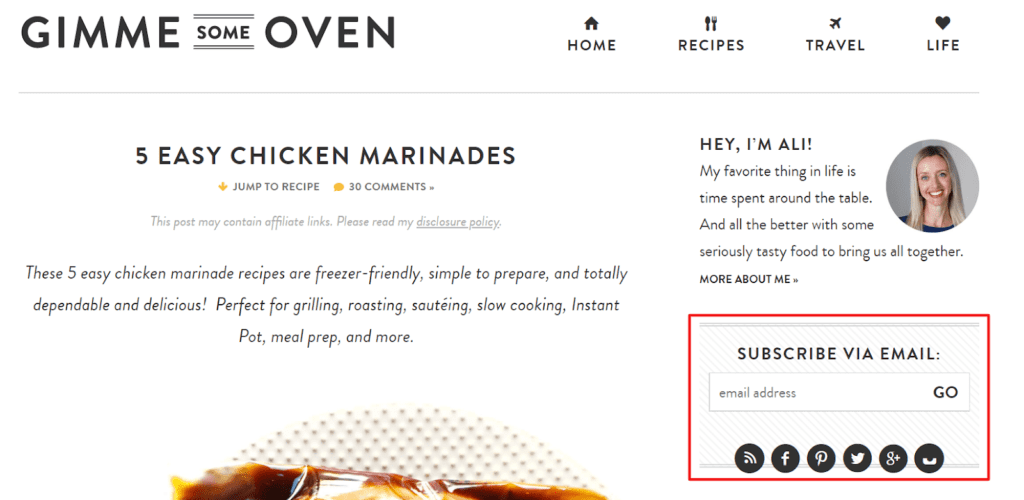

When creating a subscription form, be super clear about your signup promise — what kind of email content will subscribers receive and how often?
If you promise a bi-weekly email newsletter with content marketing tips, stick to that. If you start sending unrelated promotional content, expect people to unsubscribe, or worse, mark your emails as spam. 😱 (Very bad for deliverability rates!)
Remember: People trust you enough to give their email address in the first place, don’t abuse that trust.
Add opt-in forms to your website and other places
Place your email subscription form in highly visible places where people will definitely see it. 👁️
Typical subscription form hotspots include blog posts, the homepage, and contact page. Creating a pop-up form on your website can be a good idea, too. Just make sure not to disrupt the user experience too much. Pop-ups that prevent visitors from using your site can be big deterrents! (Think of your signup form placement like your call-to-action placement).
Share forms on social media by including a link in your bio or posts.
Run an ecommerce/online store? Include a signup option as part of the checkout process.
Supercharge your list with content upgrades and lead magnets
Nothing makes a list grow faster than premium content.
Guarded content like ebooks, reports, checklists, or infographics are great ways to grow your contact list. Visitors get valuable content in exchange for joining your newsletter list. It’s a win-win! 🏅
Special offers and discounts are a great way to get people onto your list, too. For example, clothing brand Mango offers 10% off your first order when you subscribe to their newsletter.
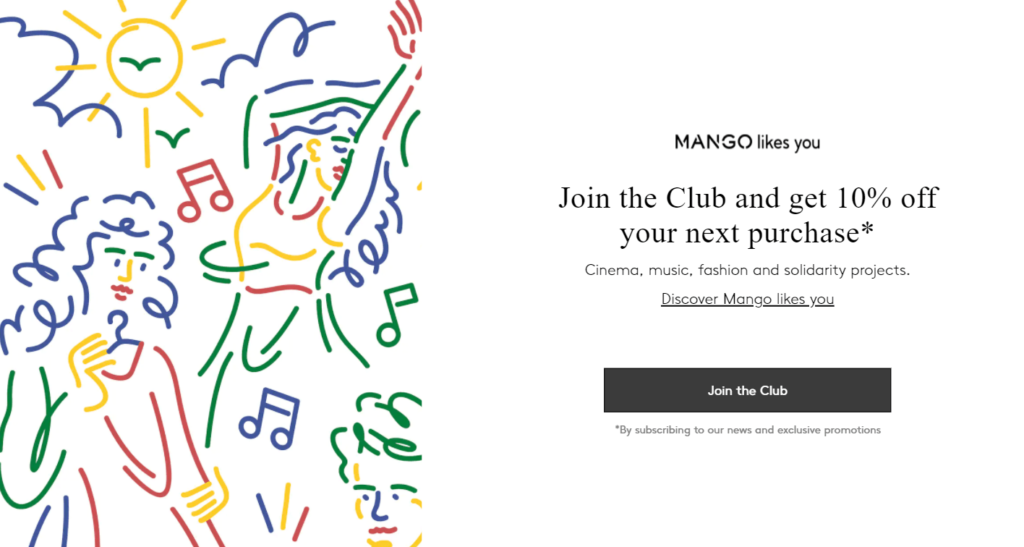

Discover more tactics in our guide to email list-building.
3. Set up a welcome email for new subscribers
When someone signs up to your email list, you’ve gotten their attention. Now it’s time to engage them even further with a welcome email. 👋
A welcome email is an automated message sent to new customers and subscribers. The idea is to introduce your brand and any content that will establish your relationship with the subscriber — a welcome discount, links to latest articles, useful information, etc.
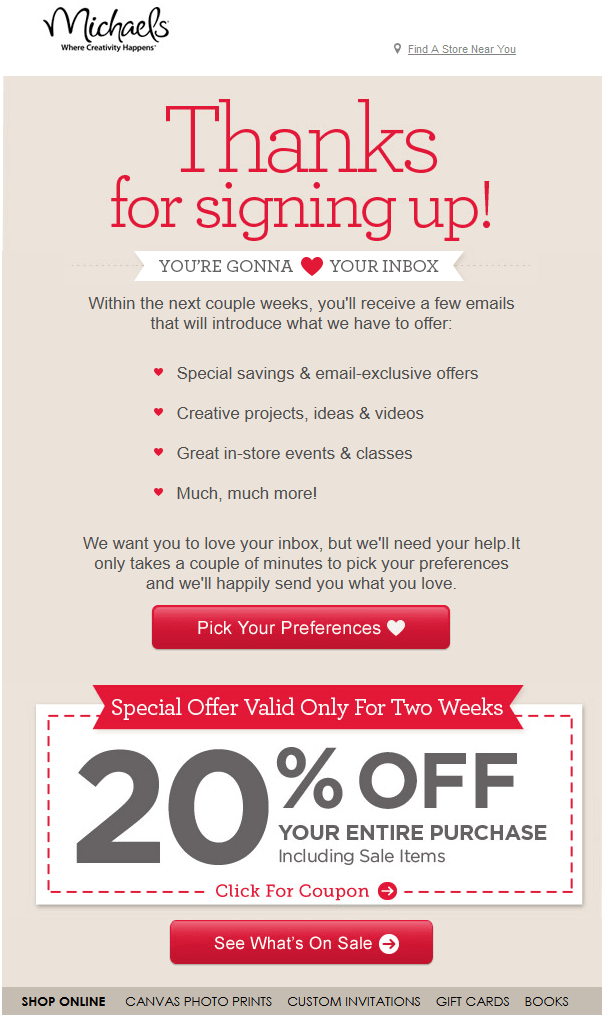
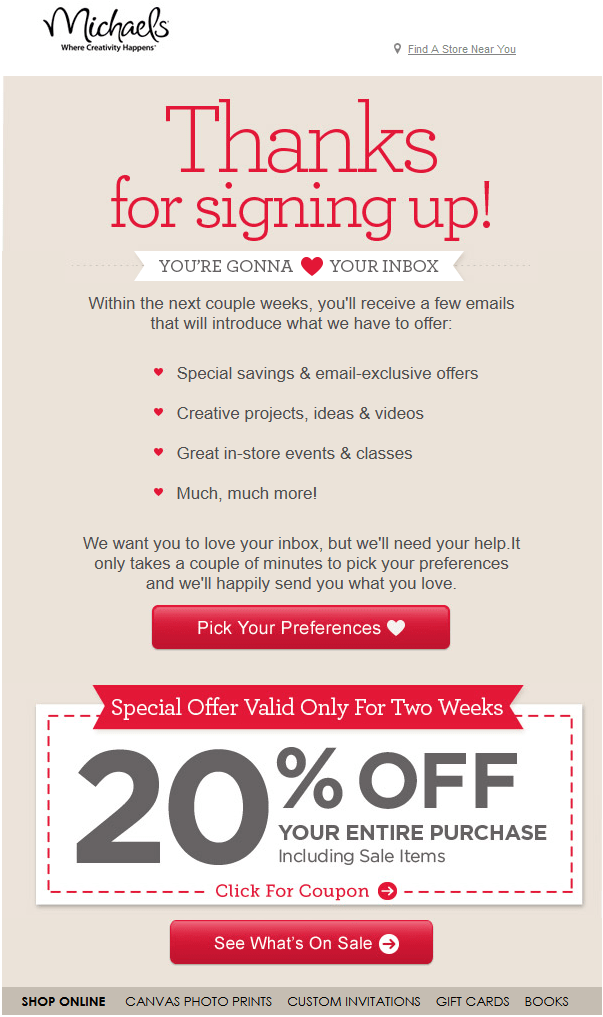
Email deliverability tip: Get subscribers to add you to their contact list so they never miss an email.
4. Define the goal of your email marketing campaign
Now that you’ve started building your email list, it’s time to think about what you want to achieve from this first campaign.
Every email marketing campaign should have a clear goal.
Examples of common goals include:
- Promoting a new product
- Sharing a discount with loyal customers
- Getting more downloads for your latest ebook
- Updating subscribers on some important piece of company news
Your goals can be specific or broad — as long as they fit with your business and your audience. In either case, having a clear goal in mind will make it easier to create your email content.
5. Build responsive emails
Responsive emails automatically adjust their formatting to fit the device they’re viewed on – mobile or desktop. 📱
You might be wondering, do I need to hire an email designer for this?
If you’re bootstrapped and on a budget, then no. You don’t need one. To make things easy, most email marketing services have some form of drag & drop email editor. These are great for producing clean, simple, hassle-free designs.
Of course, that’s not to diminish the value of having a dedicated email designer, especially for ecommerce. An email designer will help you stand out from the crowd with custom templates. It’s definitely something to consider down the line — or even now if you have the means.
That said, email design doesn’t have to be difficult or technically over your head. Using a drag and drop editor, you can create stunning and professional marketing campaigns. 🧑🎨
There’s no need to get hung up on creating fancy, elaborate emails. More importantly, you should focus on creating an email that embodies your brand, whatever it may look like. Oftentimes, this means keeping it simple. You can always build upon this later on as your skills grow.
Save time with pre-made email templates
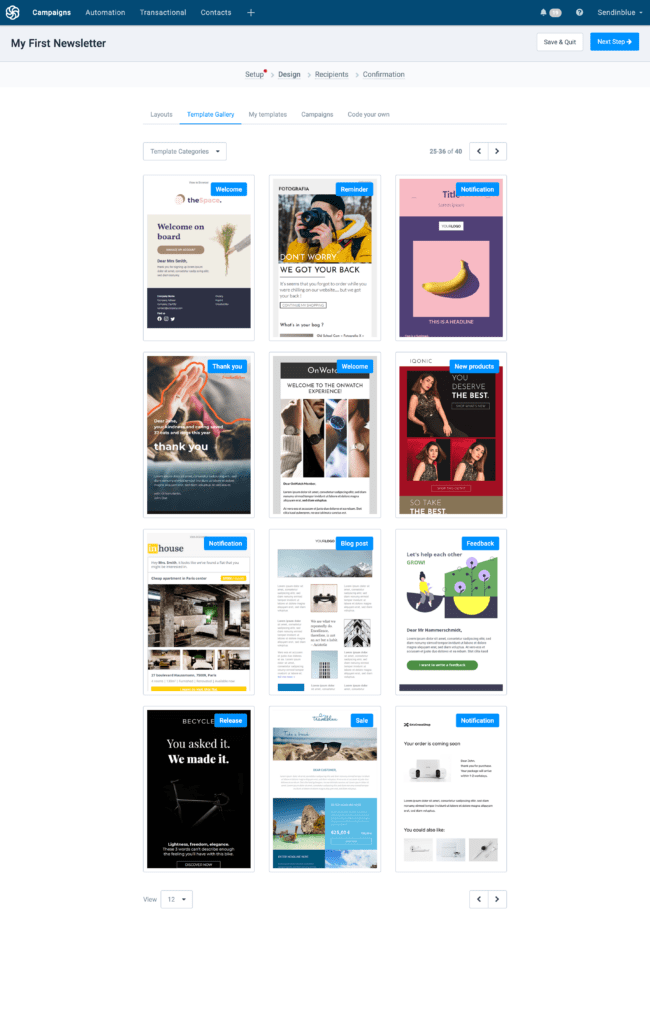

Email marketing templates are the perfect shortcut to standout email design.
If your email marketing service offers templates, pick one you like and personalize it to match your brand colors and font. 🎨
Re-use the template over and over for future email newsletters. All you’ll have to do is update the content. Quick and easy.
Sendinblue has over 40 newsletter templates available on all plans (even the free one). There are also plenty of free email templates available from other sources.
6. Write your email copy
You know your goal. You know your target audience. Now, it’s time to build on that foundation.
Your email copy needs to offer value and feature topics that interest your audience. You also need to hone in on your voice and tone. 🗣️
To write persuasive, engaging email copy, keep these tips in mind:
- Ask yourself “What does my audience need from me? How can I help?”
- Imagine you’re writing to one person.
- Show your brand personality.
- Tell a story.
- Write to instill curiosity, starting with the email subject line — more on that below.
- Use a conversational tone, i.e., write the way you speak.
- Break up the copy with short paragraphs and use bullet points where possible.
The email signature should be the name of a real person. This is more personal than a faceless brand logo.
Don’t have much copywriting experience? Don’t worry. Writing emails is something you can practice and improve at with time. 💪
6. Optimize your email open rate, clicks, and conversions
There are a number of ways to boost your email open and conversion rate, starting with your email sender name.
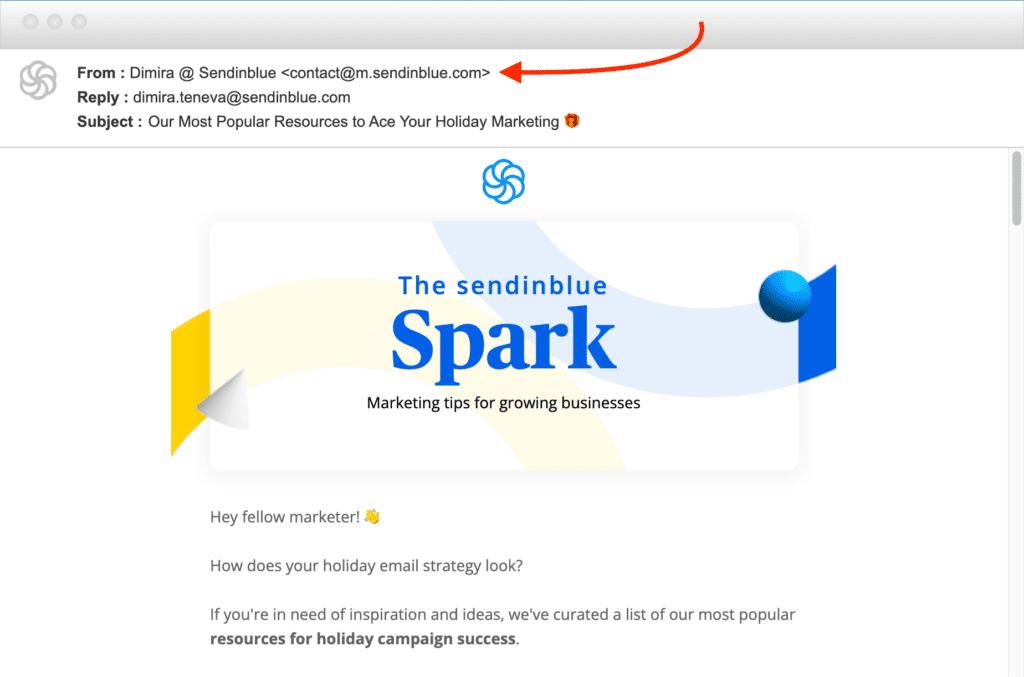
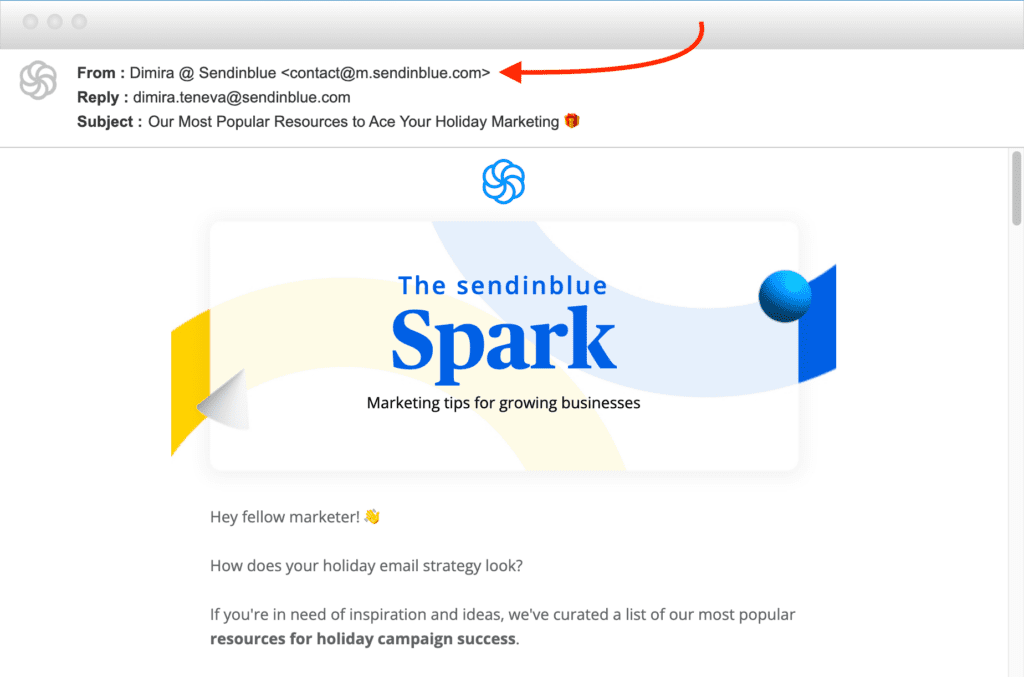
Use an easily recognizable sender name and address
When you get an email, what’s the first thing you look at? Probably who it’s from.
The sender name answers the recipient’s first subconscious question: Is this genuine or is it spam?
The best way to reinforce trustworthiness and brand recognition is to incorporate your brand name into the sender name. There are several ways to go about this:
- Your company/brand/newsletter name on its own
- A combination of brand name and your first name (e.g. Dimira at Sendinblue)
- A distinct sender name to differentiate specific types of email content (e.g. Sendinblue Product News)
To be easily recognized in the inbox, use the same sender name and address for all campaigns.
Avoid no-reply email addresses, as these diminish trust in your brand and prevent subscribers from reaching out with questions. You want engagement from your audience — why close off a potential means of communication?
Write an intriguing email subject line


Introducing one of the most important elements of your email marketing campaign: The email subject line. ✨
These few words could determine whether your email is read or not. And with so much competition in the inbox these days, they need to stand out.
Aim to create intrigue or a desire to open in just a few words.
- Keep the subject line to 50 characters.
- Highlight your most interesting offer.
- Appeal to your subscribers’ emotions and ambitions.
Take a look at our best subject line resources to boost open rates:
Optimize your email preheader/preview text
The email preheader (or preview text as it’s also known) is the snippet of text that appears after the email subject line for certain email clients, particularly on mobile devices.
The preheader adds valuable context to your subject line and can significantly boost your open rates. The subject line and preheader should work together to start telling the reader a story.
Again, it should instill enough curiosity to make the reader want to open the email and learn more. 🤔
Fail to set a preview text and the email client will see the first line of text.
“View this email in your browser” isn’t the most enticing, is it?
7. Test your email campaign before sending
Always send a test email before officially hitting send. Small mistakes can easily slip through the cracks and may harm your brand image. 🙅♂️
Keep your eyes peeled for:
- Typos
- Forgotten or incorrect links
- Text formatting errors
Have some team members proofread and check the test email on both desktop and mobile devices.
If you’re with Sendinblue, you can use the email preview feature to test different screen sizes and email clients.
When everything is good to go, double check that you’ve selected the right email list(s).
8. Schedule your campaign for the right time
Rather than choosing a random day and time to send your emails, be strategic. Choose a time that makes sense for your audience, based on what you know about them.
Most people tend to only visit their inbox a few times each day. Find a time that’ll put you top of the inbox when subscribers are checking their emails. This is sure to increase your open rates.📈
Email marketing campaigns tend to perform better when sent on Tuesdays or Thursdays in the mornings around 10:00 AM or in the afternoons around 2:00 PM.
It makes sense: Many people check their emails in the morning when they get to work, as well as after returning from lunch.
But, what works for most may not work best for you. It’s important to test different times to see where the sweet spot is with your audience.
Sendinblue Premium users get access to the send time optimization feature, which selects the best time for each individual contact based on previous engagement data. 🤓
Check out Sendinblue’s research on the best time to send an email!
8. Monitor the campaign results
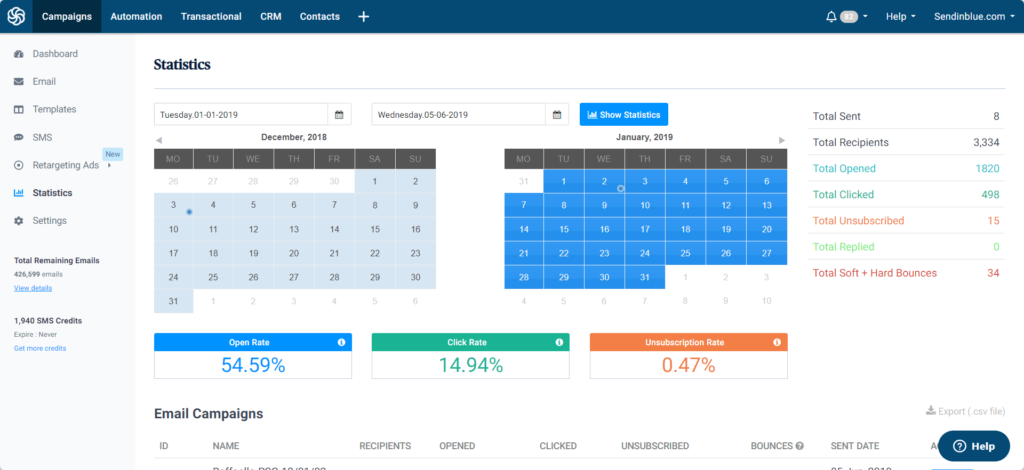
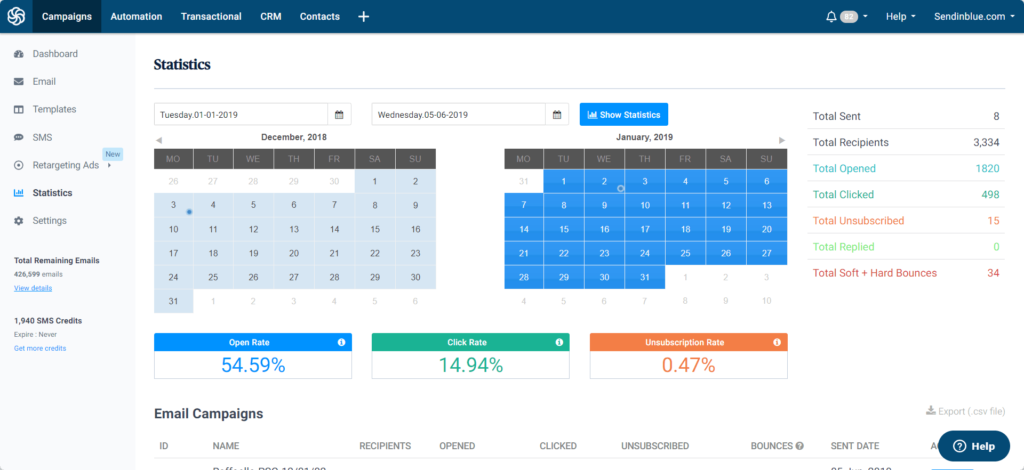
Analyzing key email marketing metrics will teach you how to improve your strategy for future campaigns. As a beginner email marketer, there will always be areas for improvement. 📋
Most ESPs have an analytics dashboard with at least the following real-time metrics:
- Open rate: The ratio of the number of people who opened your email divided by the total number of recipients.
- Click-through rate: The ratio of the number of people who clicked on a link in your email divided by the total number of recipients.
- Unsubscribe rate: The number of people who unsubscribed divided by the total number of recipients. If this number is high, you need to review your email frequency and segmentation — we’ll look at this in more detail shortly.
- Bounce rate: The number of emails that failed to deliver divided by the total number of emails sent.
- Soft bounces are due to temporary issues like the recipient’s inbox being full. Hard bounces, on the other hand, are due to permanent issues, like an inactive email address.
Further reading: How to Create a Newsletter in 9 Easy Steps
10 Strategies for Email Marketing Success
This next section focuses on strategies and best practices to do email marketing well. 💪
1. Never buy email lists
Building an email list can be slow, especially when you’re just starting out. Buying a list might seem like a tempting shortcut, but trust us — it’s a terrible idea.
Buying a list will put your business at serious risk because:
- In many jurisdictions around the world, sending unsolicited emails and storing people’s data in your CRM without consent is illegal (think GDPR and CAN-SPAM act).
- People are more likely to mark unsolicited emails as spam, damaging your email sender reputation and potentially ending you up on an email blocklist.
- Most email marketing services will refuse to work with you because purchased lists can harm the deliverability of other users on shared IP addresses.
And that’s not all. Many email addresses on purchased lists are actually spam traps. A spam trap is an inactive email address that’s purposely left out in the open to attract spammers. 🦹
Because the email address doesn’t belong to anyone, it’s impossible that it opted in to any email lists. That way, the ISP knows that whoever contacts this address is a spammer.
In short, don’t buy email lists. Build your list organically — however slowly — and you’ll reap the benefits in the long run.
2. Use double opt-in
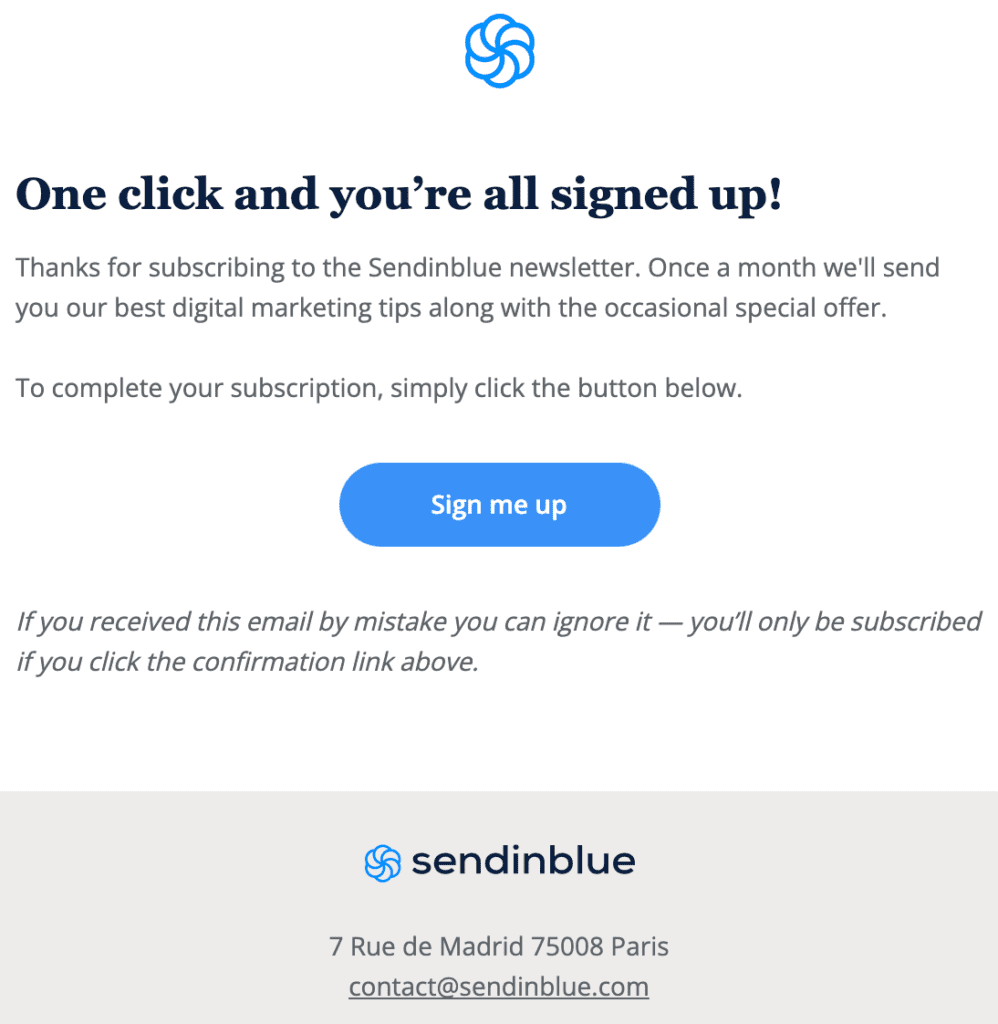
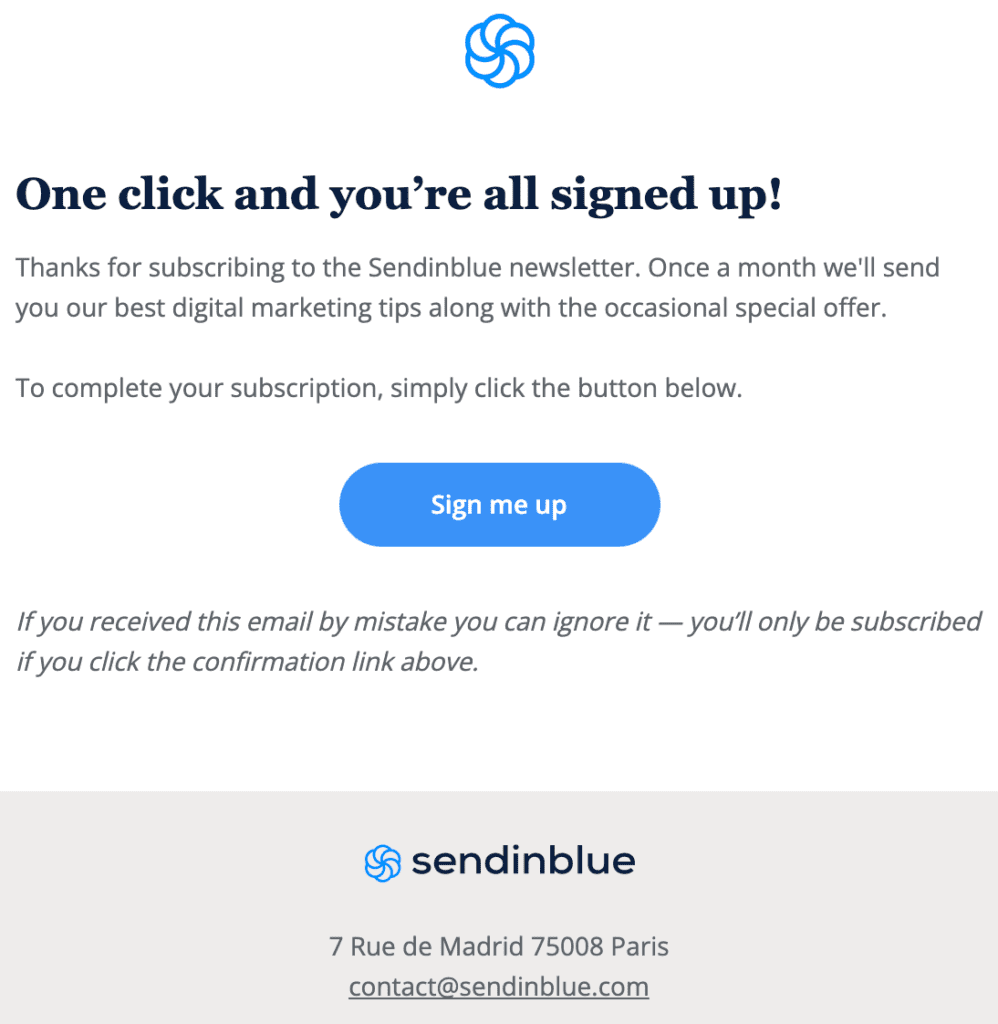
As already mentioned, the term ‘opt-in’ refers to the signup process. There are two different types of opt-in for email marketing:
- Single opt-in is when the subscriber is added to the email list once the signup form is submitted.
- Double opt-in is when you send a confirmation email with a link to each new subscriber. The subscriber must click the link to complete the subscription. Without this verification, they won’t receive emails from you.
Sure, double opt-in adds an extra step between the potential subscriber and your list. But far from being an obstacle, this process is important — especially for email deliverability.
Double opt-in eliminates any misspelled email addresses (which would otherwise generate a hard bounce). It also rules out spam traps and acts as proof of subscriber consent — a GDPR requirement. ⚖️
For better email marketing, double opt-in is the way to go.
3. Segment your mailing list
As your email list expands, it’s likely to contain diverse buyer profiles. 👥
List segmentation is the process of dividing your list of subscribers into smaller sub-lists with common traits. The idea behind this technique is to engage subscribers with more relevant, targeted emails.
Typically, contact lists are segmented by demographic information like age and location as well as customer information like lead score and purchase history. (This is where having a sales CRM that works with your email marketing tool comes in handy).
To get a head start on segmentation, you can add subscribers to separate lists during signup by asking about their email content and frequency preferences.
4. Personalization
Who doesn’t like to feel noticed? 🤗
People generally appreciate when brands add personal touches and pay attention to small details. When it comes to making us feel valued and understood as a customer, a little effort goes a long way.
This also rings true for email marketing.
Email personalization is essential to building trusting relationships with prospects and customers.
Here are some simple email personalization ideas that’ll positively impact your open, click through, and conversion rate.
- Use subscribers’ first names in the email subject line and content (“Hey Tom!”).
- Consider time zones when scheduling campaigns to maximize the chances of your email being read. Where are the bulk of your subscribers located?
- Segment contacts so that messaging is targeted and relevant.
- Use behavior-triggered emails based on how customers interact with your product/service.
For a more complete guide, check out our article on Personalized Emails: How to Reach Customers and Generate Sales.
5. Optimize for mobile
61.9% of all emails are opened and read on mobile devices. 📱 To get the best results, make sure your emails display correctly across devices.
Depending on the email design capabilities of your ESP, it’s likely that mobile-responsiveness is an already built-in feature.
All emails designed in Sendinblue are automatically programmed to fit mobile devices, and you can double check this using the mobile preview functionality.
6. Optimize email deliverability
Even more than subject lines, the call to action, and copy, email marketing success hinges on reliable email deliverability.
All-important for email marketers, email deliverability refers to the ability to deliver an email to the inbox.
When all goes according to plan, the email makes it past the spam filters and arrives at its destination. When deliverability is compromised, the email lands in the spam folder or, worse, your sender IP is blocklisted by the ISP. 😱
While deliverability often depends on technical factors, there are plenty of non-technical ways to help your email newsletters reach the inbox.
Here are some easy deliverability best practices:
- Make sure the email subject line doesn’t come across as spammy or overly promotional. If a contact decides your email is spam before even opening, your deliverability rate is likely to suffer.
- Keep your subscriber database up to date by removing unengaged contacts and inactive addresses.
- Only send to opt-in subscribers. Send emails to someone who’s never heard of you and it’s likely they’ll report you as spam. This will harm your future deliverability.
- Always include an unsubscribe link. Under the GDPR (Europe’s data protection regulation), an individual has the right to dictate how their data is being used. The act of unsubscribing falls fully within those rights so this option should always be available.
More tips to improve email deliverability (and a free ebook) available here.
7. Choose an engaging email newsletter design
When it comes to email marketing, design is just as important as the content. The look and feel of your email is going to communicate a message about your company and its values. Spend some time getting it right. 🖼️
Ideally, you want to capture attention with an on-brand email design that highlights your main message and CTA in the best way possible.
Great email design supports email content by making it clear, legible, and structured. A structure that naturally draws the reader to your call-to-action will drive up your click-through rate. 💯
If you intend to add images to your email content, keep in mind these best practices for newsletter images:
- Don’t clutter the email with too many images (this could harm your deliverability).
- Avoid images that are either too large or too small.
- Add ALT text for each image in case it doesn’t show and to make it more accessible to people using screen readers.
- Only use high quality images that serve a purpose. Avoid generic stock photos that don’t add value.
For the best email design inspiration, check out ReallyGoodEmails.
HTML or plain text
It’s a long-standing debate among email marketers — HTML vs. plain text, which is better? 🤔
Plain-text can be just as effective as HTML. It all boils down to your audience and the types of emails you’re sending.
If you’re a writer with a writing tips newsletter, plain-text makes sense. On the other hand, ecommerce emails will need to be more eye-catching. The best way to know? Test! 👩🔬
Watch this Sendinblue Academy video for more insights into HTML vs. plain text.
8. Clean your email list regularly
Keep your database up to date for optimal email deliverability and higher engagement rates.
Got subscribers who’ve dropped off the radar? If someone hasn’t engaged with your emails in at least six months, send a reactivation campaign or even ask for a second opt-in. See if you can get them interested again.
If there’s still no engagement, delete the subscribers from your list. 🧹
Sure, it’ll be sad to see them go but better for your deliverability in the long term.
Another important point: Make it easy to unsubscribe with a clearly visible unsubscribe button. If people can’t find the way out, they’re more likely to mark you as spam.
For reference, a good unsubscribe rate is 0.5 or less.
9. A/B test your email subject line and content
Hesitating between two subject lines? Not sure what content your audience will react best to? A/B testing is one way to find out — and a great way to optimize your campaigns.
Test different email subject line formulas, content formats and CTAs. See which ones get the best engagement and stick with the approach.
Keep testing until you find what works best for your subscribers!
10. Scale with autoresponders and email automation
Once you’ve got the hang of things, automate your email marketing strategy to make your business grow even faster.
Autoresponders are the simplest form of email automation.
Autoresponders send an automatic personalized email (or email series) at different stages of the buyer journey. You get to follow up with subscribers without having to be physically present to hit send. 💅
The welcome email is the most common autoresponder example and most email marketing services have an autoresponder function.
Armed with the right email automation software, you can go one step further and set up complex email automation sequences using if/then/else logic. This kind of email series is highly effective for lead nurturing and lead scoring.
Further reading: 11 of the Best Marketing Automation Services in 2022
Where Can I Learn More about Email Marketing?
If you’re determined to become an email marketing expert, then you’ll love the Sendinblue Academy email marketing course.
Complete the course and you’ll get an email marketing certification to add to your CV and LinkedIn. And the best part? It’s completely free! 🎉
Conclusion
Hopefully this article has given you a better idea of the world of email marketing.
From small businesses to large enterprises, anyone can benefit from a well-thought out email marketing strategy and campaign.
To keep up with the latest tips and tricks, subscribe to our monthly newsletter:
 Deutsch
Deutsch



















Comments
Thank you – this is a very useful blog particularly for anyone who hasn’t tried an email campaign
Your blog is easily understandable and gives complete information about email marketing. Very helpful to select from the various choices mentioned in the list. The features, pros, and cons section help me to determine the best tool for my relevance.
It is true that your online presence is incomplete without a great e-mail marketing tool.
All the points are clearly explained in detail, making it a very useful guide for the ones who are in search to improve their online presence.
Moreover, Sendinblue offers a complete e-mail marketing solution to small entrepreneurs in one shot.
Its Lite plan is perfect for new marketers or small businesses offering you to send up to 1,00,000 e-mails with no daily sending limit.
A/B testing is a great way of knowing which e-mail campaign is going to yield the best results.
Another important aspect that one should be clear about in choosing an e-mail marketing tool is the e-mail deliverability rate.
A high rate indicates that your e-mail just enters into the e-mail box of the subscriber, not into the spam box.
Overall, it is a great post.
Welldone Job Emma!
Thank you
Yash 🙂
Nice article and thank you this valuable information
Ready to find your marketing zen?
Take the stress out of your work day with a solution that’s built for you!
Get started free